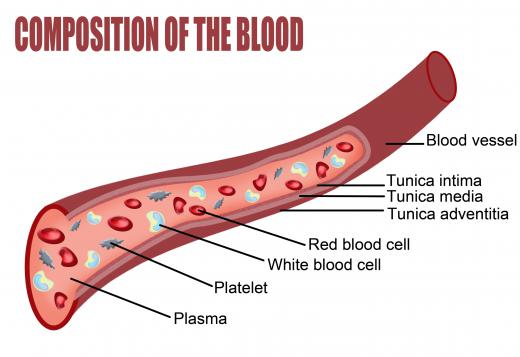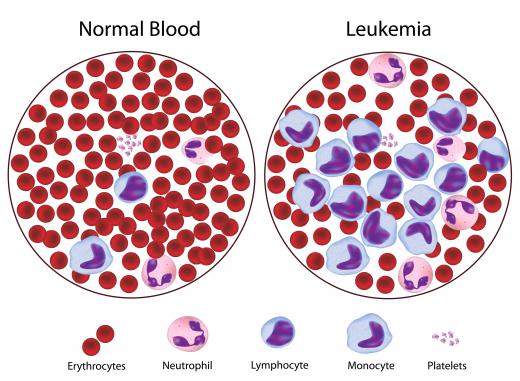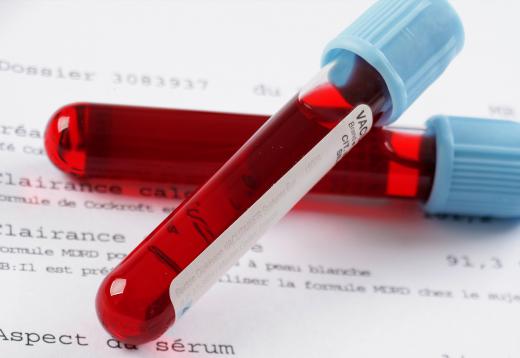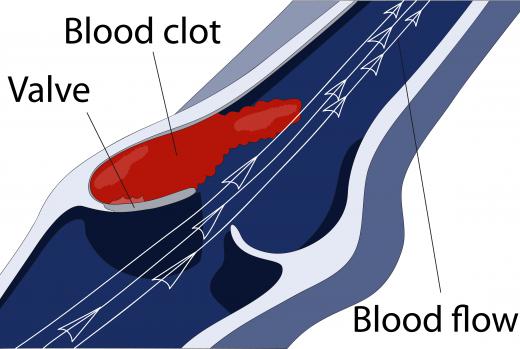What is Mean Platelet Volume?
In medicine, mean platelet volume (MPV) is a measurement that describes the average size of platelets in the blood. Platelets are not true cells, although they are often referred to as such. Like red blood cells, they are formed in the bone marrow, but are much smaller, and are involved in the clotting of blood, helping to stop bleeding in event of injury. An MPV may be carried out as part of a complete blood count (CBC). The importance of mean platelet volume lies in the fact that it provides an indicator as to whether the bone marrow is manufacturing them normally.
Platelet Formation and Function

Platelets come from cells in the bone marrow known as megakaryocytes. These are extremely large, but after a point, they split up to form platelets, typically releasing over 1,000 into the bloodstream. They flow through blood vessels, and when damage to the vessel wall occurs, they stick to it, and to each other, forming fibrous structures that seal up the breakage. Platelet aggregation works to stop bleeding when tissues, veins, or arteries are cut, or suffer other kinds of physical damage.
The Importance of MPV

A platelet count — often referred to as Plt — shows whether a person is producing normal amounts of these cell fragments. If the count is lower or higher than normal, this may be a sign of a blood or bone marrow disorder. An MPV test measures the sizes of platelets in a blood sample to determine the average; a patient’s MPV may enable a doctor to detect a problem before it shows up in a Plt test. The two tests in combination are used to detect a variety of conditions, many of them serious. A high MPV indicates increased production of platelets, and a low MPV, decreased production.

A normal measurement for MPV is typically in the range of 5.0 – 15.0 femtoliters — a femtoliter is one quadrillionth of a liter. The measurement, however, normally needs to be assessed in conjunction with several other factors in order to determine what a satisfactory range is for a specific patient. Research suggests that the average healthy size of platelets may differ in people from different parts of the world. Individuals of Mediterranean descent, for example, are believed to have a higher than average platelet size.
Conditions Associated with High MPV

Elevated mean platelet volume is common in patients with certain forms of diabetes. If combined with a low Plt result, this indicates a condition that results in destruction of platelets. These include immune thrombocytopenia, where the patient’s immune system destroys platelets; pre-eclampsia, a complication during pregnancy that elevates blood pressure; sepsis, an inflammatory response to an infection; or various hereditary conditions. High MPV with a normal Plt test result may be a sign of chronic myeloid leukemia, a condition in which too many of a type of white blood cell are produced; or hyperthyroidism, — over-production of thyroid hormones. Accompanied by a high Plt result, it may indicate a bone marrow disorder that causes excessive cell production.
Conditions Associated with Low MPV

In association with a low Plt value, this can indicate a form of anemia, or may result from therapy involving treatment with drugs that are toxic to cells, for example, in chemotherapy used to treat cancer. If combined with a normal Plt, it may indicate chronic kidney failure. Accompanied by a high Plt, it can indicate an infection, inflammation or some form of cancer.
Problems Caused by Abnormal MPV
As well as indicating underlying conditions that require investigation, an abnormal MPV can itself put a patient at risk. An elevated MPV means that the blood has a greater tendency to clot, which can increase the risk of thrombosis, stroke and cardiovascular disease. Aspirin is sometimes prescribed for this condition, as it makes it more difficult for platelets to clump together and form clots. A person with low MPV may bleed more easily; aspirin should be avoided in this case.
AS FEATURED ON:
AS FEATURED ON:















Discussion Comments
Hi, I just completed my annual work physical and the doctor told me that my MPV last year was 7.1 and this year it was 6.9. Normal platelets for both tests. (this year 266) He told me he was unsure if it was clinically significant. Is this something I should follow up with my personal doctor? Everything else in my blood work was normal.
So, I've had prints of my blood tests over last 11 years to find that after being told "all normal"
Actually, they're not!
MPV fL Neutrophil 10*9/L
11.3 5.2
12.5 5.05
11.8 2.83
12. 2.1
12.4 1.95
10.9 2.12
10.8 1.9
All have abnormal next to them but, nothing has ever been said/tested.
I have been diagnosed B12 deficient. I now have one jab weekly.
I take coumadin. Will this affect my MPV?
anon100018 is right, platelets are not a type of red blood cell.
why does a spleen problem cause a low blood platelet count?
Platelets are of course not "a type of red blood cell". They are not colored at all and have little in common with red blood cells. --HJK
Anything about 50,000 platelets is no cause for concern. Typically, doctors will take action when the platelet count dips below 20,000. This is not hard and fast rule. Doctors base treatment and course of action on symptoms, test results, and family history.
There are a few different things that may be responsible for a low blood platelet count. Sometimes having bone marrow that does not produce enough of these platelets can result in a blood platelet count. Also, there is a condition where the body uses and destroys platelets even when the marrow produces enough, causing the number of platelets to be diminshed. Sometimes spleen problems can cause a low blood platelet count, as well.
Post your comments